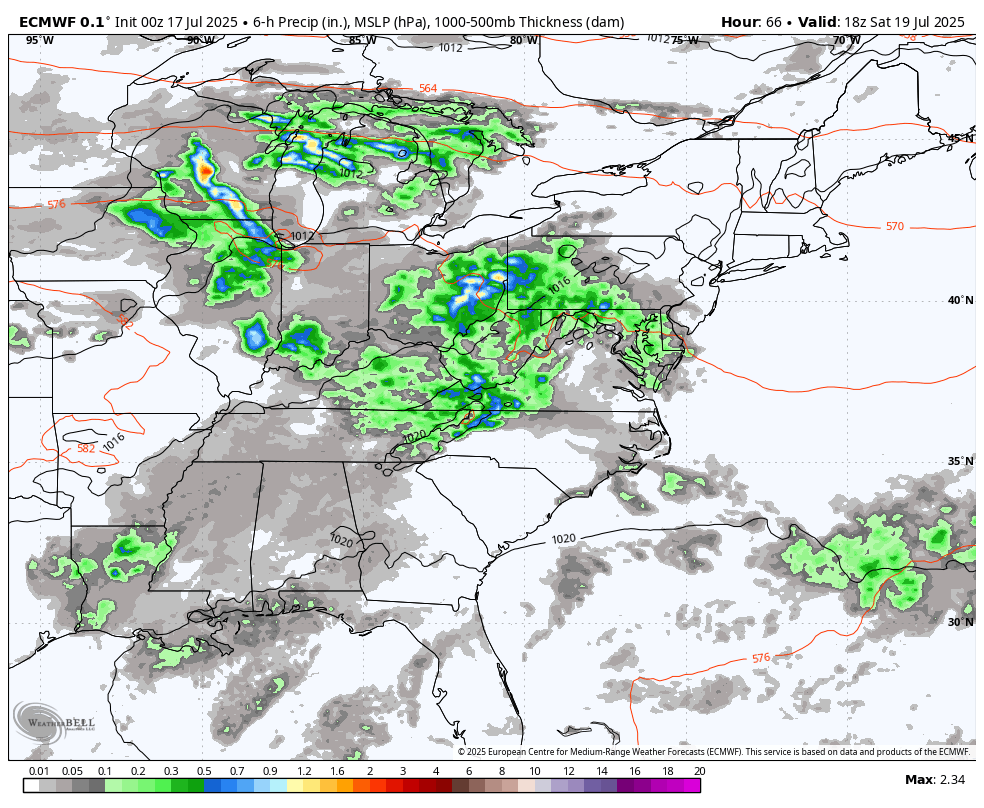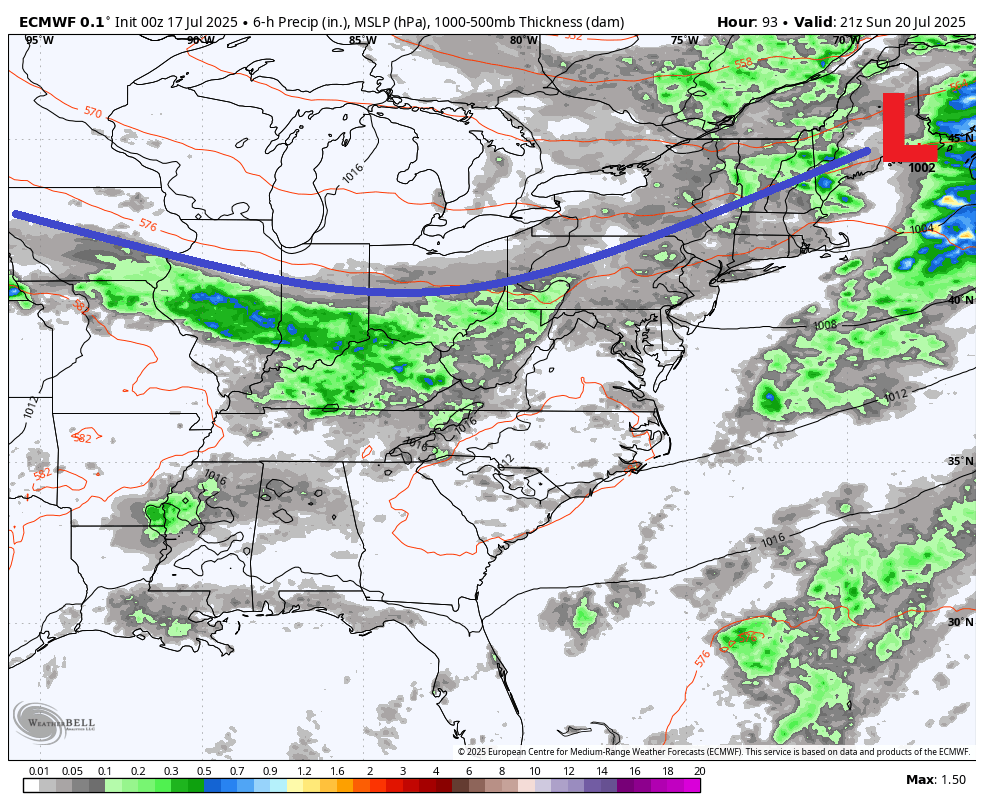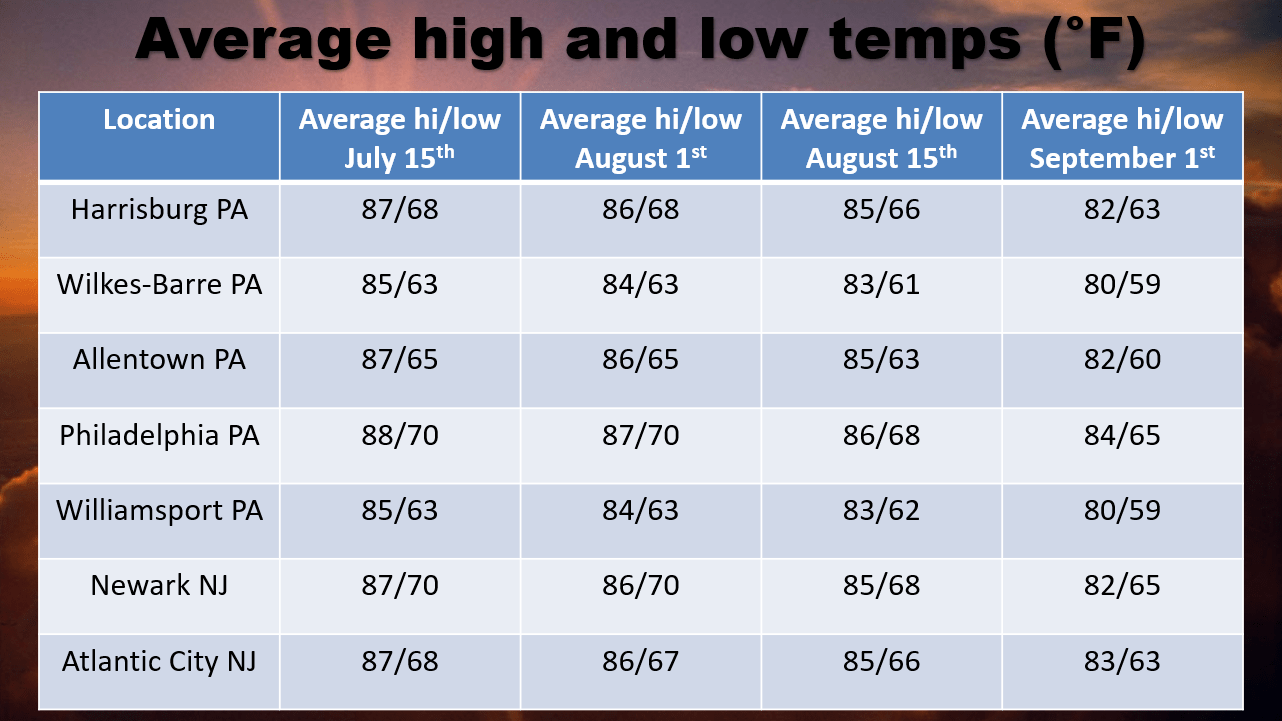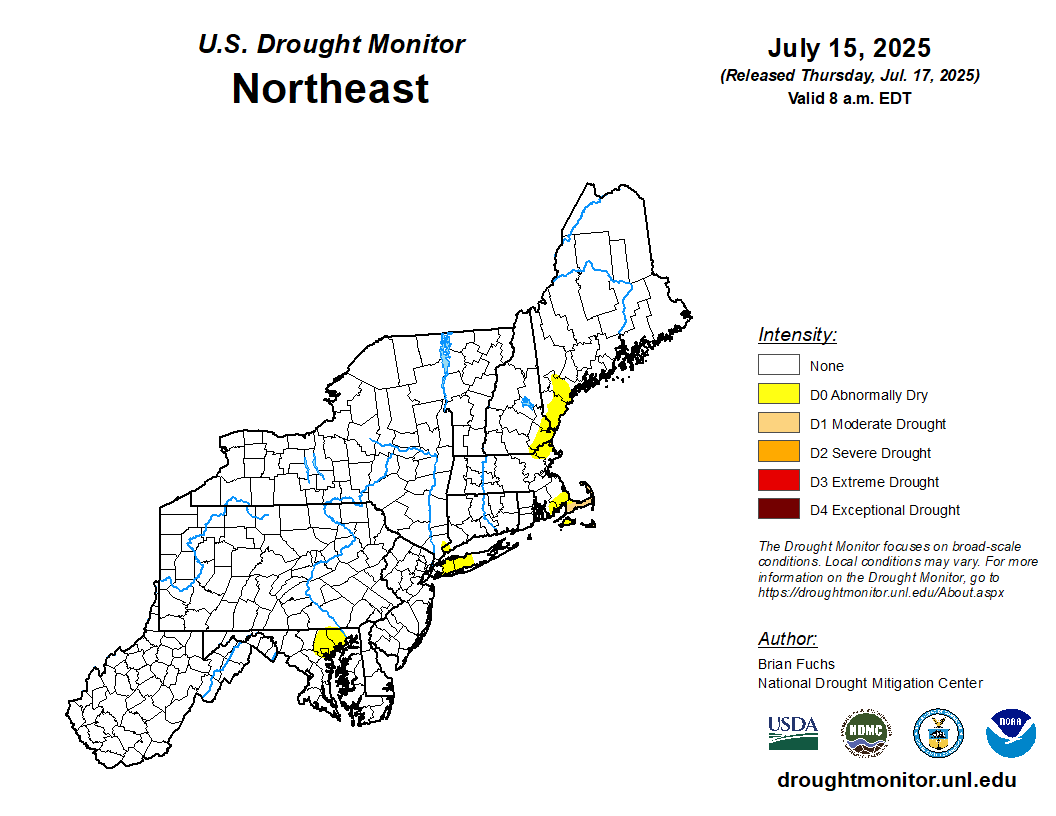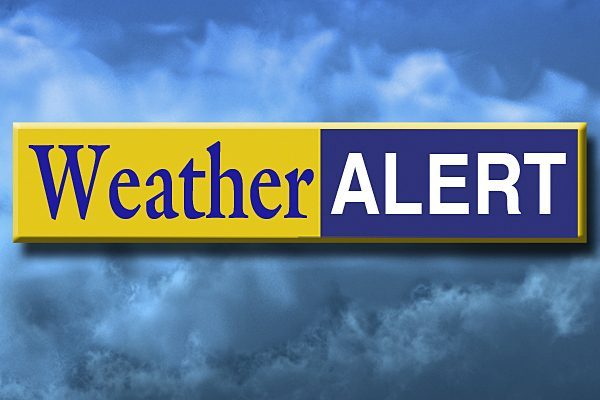EPAWA's Long Range Outlook
EPAWA's long range outlook is updated weekly every Friday morning before noon
Long range outlook most recently updated Thursday July 17th, 11:30 AM
Technical discussion is below for advanced readers:
Technical discussion below will feature two (2) subcategories: Precipitation, and Pattern Discussion. Storm possibilities will be discussed exclusively in the Premium Forum with intense model analysis leading up to any major snow, ice, or rain events, not publicly. To join this discussion and hear the updated thoughts from our team, visit The My Pocket Meteorologist Page by clicking HERE and select the "Premium Weather Forum" option.
Precipitation Discussion
OVERVIEW: The US drought monitor (photo toward the bottom of this outlook) maintains NO drought areas within our Pennsylvania, New Jersey, or Delaware locales. One abnormally dry area remains over Baltimore and Harford Counties in Maryland, otherwise the remainder of Maryland has no drought designation. This is largely due to quite an impressive month of May with a top 5 rainfall month all-time in some locations, and generally near average precipitation following in June, and near to slightly above average precipitation thus far in July. Going forward, the month of July as a whole projections were slightly adjusted this week to a near to slightly above average (+0.0" to +1.0") precipitation departure for the month as a whole. August monthly projections were also adjusted this week to a near average (-0.5" to +0.5") precipitation projection in accordance with longer term climate models and global observation trends.
Shorter term, the cold front that moved through late Thursday will stall to the south of the region Friday, and remains there to begin Saturday. Late Saturday and Saturday evening, the front returns northward as a warm front, and at the same time, low pressure will traverse this boundary and bring scattered showers Saturday night. This activity ends by daybreak Sunday, then a cold front quickly follows Sunday afternoon with scattered thunderstorms possible. In the wake of that front, high pressure builds in early next week, then moves offshore later in the week.
The month of July projections were slightly lowered this week to a near slightly above average (+0.0" to +1.0") precipitation departure, with the expectation that overall precipitation events and frequency will abate somewhat beginning next week. The month of August projections for the month as a whole were also adjusted this week to a near average (-0.5" to +0.5") precipitation departure, using longer term climate models as well as seasonal trends.
Breakdown of precipitation departures from normal over the next several weeks:
July 19th - July 25th: Near average
July 26th - August 1st: Near to slightly below average
August 2nd - August 8th: Near average
August 9th - August 15th: Near to slightly above average
August 16th - August 22nd: Near average
August 16th - August 22nd: Near to slightly below average
Public/free available maps will be updated when a threat is imminent for significant weather on the weather alerts page throughout the year: http://epawaweather.com/weather-alerts/
Note: Any image below is clickable for larger viewing
Pattern Discussion
OVERVIEW: The month of July projections were maintained this week for a near to slightly above average (0.0°F to +2.0°F) temperature departure for the month as a whole, with higher dewpoints keeping overnight lows higher despite the absence of long stretches of extreme high temperatures. August projections for the month as a whole were also maintained this week for a near to slightly above average (+0.0°F to +2.0°F) temperature projection using long term climate guidance and seasonal/global observation trends, and the expectation of much of the same type of pattern through at least mid-August.
- The overall pattern through for the remainder of July features temperatures that will be very typical summerlike... absent of long periods of extremes. We do expect that Friday through the middle of next week we'll see a bit of a break with a near to slightly below average period overall before high pressure moves offshore late next week and the heat returns for several days. With the exception of a few days of lower humidity, the higher dewpoints overall will limit the extended heatwave chances except on a shorter-term and transient basis. The near to slightly above average projection is more about the warmer overnight lows than it will be about high temperature extremes during the day, but there will most certainly be some 90° days mixed in over the remainder of this month. During the last 10 days or so of July, the expectation is for the dominant upper-air ridging to retreat to the Southern Rockies and Western Plains, which will place our area in a NW flow aloft. This general pattern configuration features fast-moving (possibly severe) thunderstorm complexes, and is expected to maintain through early August according to longer-range climate guidance.
- The Madden-Julian Oscillation (MJO) is currently in phase 5 in the Maritime Continent, and is largely expected to quickly move into the Western Pacific phase 6 by early next week. A continuation of Western Pacific forcing is expected (phases 6 and 7) through at least the end July and perhaps the first half of August. This typically promotes temperate conditions (typical summertime weather for July and August) in the current ENSO neutral background state, and also promotes the aforementioned best ridging to retreat to the SW US during the final 10 days of July. This will likely result in a stagnant NW flow aloft at that time, which aids in frequency of precipitation and thunderstorm events.
- A composite average of the SST departures in the ENSO regions places it in ENSO neutral territory as it has been for the past several months. The Niño 1+2 region (eastern Pacific near Peru) is currently the warmest of the 4 ENSO regions at +0.4°C, whereas the other regions (Niño 3 and Niño 4) are near -0.1°C, and Niño 3.4 is currently -0.2°C, placing the entire Pacific basin solidly in ENSO neutral territory. The expectation is for ENSO neutral to remain throughout the Summer months, which typically favors near to slightly above average temps in the June/July/August 3-month period, and near to slightly above average precipitation is typical of July and August.
Average high temperatures are currently in the 85-88 °F range from north to south across our coverage region, which is at peak annual climatological maximums, and the highest average temperatures of the year which will maintain for another 10-14 days. Any above or below average stretches listed in the outlook will be relative to seasonal norms at that time, and it is important to note that cooler/warmer periods will be relative to the time of year we are talking about. For example, the near to slightly below average temperatures listed for the July 18th-23rd period generally features highs in the lower to middle 80s, coming at a time when average highs are typically in the mid-upper 80s. Use the average highs/lows chart below providing a point of reference and transparency for what average temperatures are at each corresponding location through September 1st.
The month of July projections were maintained this week for a near to slightly above average (+0.0°F to +2.0°F) temperature departure for the month as a whole, with the expectation of warmer overnight lows contributing more to the overall temperature departures more so than the daytime high extremes. The month of August as a whole was maintained this week for another near to slightly above average (+0.0°F to +2.0°F) temperature projection, using long term climate guidance and seasonal/global observation trends.
Note: Any image below is clickable for larger viewing
Long Range Outlook Table
| Date(s) | Threats | Significance | Confidence |
| 7/18-7/23 | Temperature | Near to slightly below average | Very high |
| 7/25-7/28 | Temperature | Near to slightly above average | High |
| 7/29-7/31 | Temperature | Near average | Moderately high |
| 8/1-8/8 | Temperature | Near average | Moderate |
| 8/9-8/16 | Temperature | Near to slightly above average | Moderately low |
| 8/17-8/24 | Temperature | Near to slightly above average | Low |
| 8/25-8/31 | Temperature | Slightly above average | Very low |
| 7/19 | Warm front | A previously stalled frontal boundary to our south will return northward as a warm front Saturday evening; low pressure traverses the boundary and brings showers overnight Saturday night | High |
| 7/20 | Cold front | A cold front quickly follows on Sunday afternoon with scattered showers/thunderstorms possible | Moderately high |
| July as a whole | Temperature | Near to slightly above average (+0.0°F to +2.0°F) | High |
| July as a whole | Precipitation | Near to slightly above average (+0.0" to +1.0") | Moderately high |
| August as a whole | Temperature | Near to slightly above average (+0.0°F to +2.0°F) | Moderate |
| August as a whole | Precipitation | Near average (-0.5" to +0.5") | Moderate |
Long range outlook table last updated: Thursday July 17th, 11:30 AM. Next scheduled update: Friday 7/25.
This is a weekly updated public long range guidance product from EPAWA. For daily long range updates and more detailed updates M-F, please join the EPAWA forum.
More information/sign-up at: http://epawaweather.com/mpm/
Climatology
*Indications of above or below average temperatures in the table above are relative to what is considered "normal" using data collected over the long term for a particular date. This is collected and maintained by the National Climatic Data Center in conjunction with the National Weather Service actual data from previous years collected at official ASOS/climatology stations across our coverage area. Also note that as time moves forward into a different period as shown above, average temperatures for those dates will also change. See the example below using Philadelphia, PA as the climate station, which represents out projections on that precise date listed:
| Date | Average Hi/Lo (°F) | Current EPAWA projection |
| July 19th | 88°F/70°F | Near to slightly below average |
| July 26th | 88°F/70°F | Near to slightly above average |
| August 2nd | 87°F/70°F | Near average |
| August 9th | 87°F/69°F | Near to slightly above average |
| August 16th | 86°F/68°F | Near to slightly above average |
| August 23rd | 85°F/67°F | Near to slightly above average |
| August 30th | 84°F/66°F | Slightly above average |
The departure from normal uses the average temperature for the date, averaging temps over 24 hours for any given location, using both high and low temperatures hourly during any particular day. This outlook determines warm vs. cool periods relative to normal temperatures.
Climate Prediction Center (CPC) Graphical Products
These products are from the NOAA Climate Prediction Center (CPC) and do not necessarily reflect the EPAWA forecast which is detailed above. All images below update automatically as the CPC releases new graphical products
U.S. Soil Moisture Anomaly
US drought monitor (NE US)
Forecaster: EPAWA Meteorologist Bobby Martrich
Discussion last updated: Thursday July 17th, 11:30 AM


